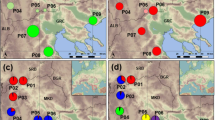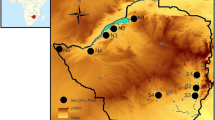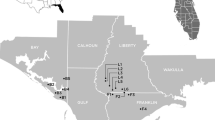Abstract
Acacia visco is a tree native to South America that grows in central and northwest region of Argentina, north Chile and Bolivia and has also been introduced to Africa and naturalized in Europe. Little is known about genetic diversity and genetic structure of this species. Therefore, we studied natural Argentinean populations of A. visco using the AFLP technique, by determining the genetic diversity of the species and its genetic structure, considering the proportion of the species diversity explained within and between the two sub-regions where populations were this species is present in the country. Fourteen of the 445 loci obtained appeared to be under diversifying selection. The remaining 431 neutral loci showed a mean of 60.89 % of percentage of polymorphic loci. The estimates of genetic diversity H E were generally high. The F ST (0.126) was highly significant, providing evidence for genetic structure among populations. Hierarchical AMOVA indicated that variation between sub-regions was 2.1 % and highly significant. The higher component of variance was found within populations (77.4 %). STRUCTURE analysis showed an optimal number of K = 6. This result was consistent with those obtained by UPGMA from Nei’s distances and Canonical Discriminant Analysis. Since differentiation of A. visco populations in sub-regions was highly significant, a suitable management strategy for the use of this species in restoration programs would be focus on sampling seeds of a high number of individual trees within populations and also ensure a comprehensive coverage of the entire ecological amplitude of this species.




Similar content being viewed by others
References
Aronson J (1992) Evolutionary biology of Acacia caven (Leguminosae, Mimosoideae): infraspecific variation in fruit and seed characters. Ann Missouri Bot Gard 79:958–968
Avise JC (2006) Phylogeography. Harvard University Press, Cambridge
Bensch S, Akesson M (2005) Ten years of AFLP in ecology and evolution: why so few animals? Molec Ecol 14:2899–2914. doi:10.1111/j.1365-294X.2005.02655.x
Bernhardt P, Kenrick J, Knox RB (1984) Pollination biology and the breeding system of Acacia retinodes (Leguminosae: Mimosoideae). Ann Missouri Bot Gard 71:17–29
Bonin A, Ehrich D, Manel S (2007) Statistical analysis of amplified fragment length polymorphism data: a toolbox for molecular ecologists and evolutionists. Molec Ecol 16:3737–3758. doi:10.1111/j.1365-294X.2007.03435.x
Burkart R, Bárbaro NO, Sánchez RO, Gómez DA (1999) Ecorregiones de la Argentina. Administración de Parques Nacionales, Buenos Aires
Butcher PA, Moran GF, Perkins HD (1998) RFLP diversity in the nuclear genome of Acacia mangium. Heredity 81:205–213. doi:10.1046/j.1365-2540.1998.00392.x
Cabrera AL (1976) Regiones fitogeograficas Argentinas. In: Ferreira Sobral EF (ed) Enciclopedia Argentina de Agricultura y Jardinería. ACME, Buenos Aires, pp 1–85
Campbell D, Duchesne P, Bernatchez L (2003) AFLP utility for population assignment studies: analytical investigation and empirical comparison with microsatellites. Molec Ecol 12:1979–1991. doi:10.1046/j.1365-294X.2003.01856.x
Casiva PV, Vilardi JC, Cialdella AM, Saidman BO (2004) Mating system and population structure of Acacia aroma and A. macracantha (Fabaceae). Amer J Bot 91:58–64. doi:10.3732/ajb.91.1.58
Chiveu CJ, Dangasuk OG, Omunyin ME, Wachira FN (2008) Genetic diversity in Kenyan populations of Acacia senegal (L.) willd revealed by combined RAPD and ISSR markers. African J Biotech 7:2333–2340. doi:10.5897/AJB08.394
Cialdella AM (1984) El género Acacia (Leguminosae) en la Argentina. Darwiniana 25:59–111
Coart E, Van Glabecke S, Petit RJ, Van Bockstaele E, Roldán-Ruiz I (2005) Range wide versus local patterns of genetic diversity in hornbeam (Carpinus betulus L.). Conservation Genet 6:259–273. doi:10.1007/s10592-004-7833-7
Covas G, Schnack B (1946) Número de cromosomas en Antofitas de la Región de Cuyo (República Argentina). Revista Argent Agron 13:153–166
Dyer RJ (2008) GeneticStudio: Population genetic software that doesn’t suck. Available at: http://dyerlab.bio.vcu.edu. Accessed 16 Aug 2015
Dyer RJ, Westfall RW, Sork VL, Smouse PE (2004) Two-generation analysis of pollen flow across a landscape v: a stepwise approach for extracting factors contributing to pollen structure. Heredity 92:204–211. doi:10.1038/sj.hdy.6800397
Excoffier L, Smouse P, Quattro J (1992) Analysis of molecular variance inferred from metric distances among DNA haplotypes: application to human mitochondrial DNA restriction data. Genetics 131:479–491
Felsenstein J (2005) PHYLIP (Phylogeny Inference Package) version 3.6. Distributed by the author. Department of Genome Sciences, University of Washington, Seattle
Fernández OA, Russo CA (1997) Arid and semi-arid rangelands: two thirds of Argentina. Rala Rep 200:41–60
Foll M, Gaggiotti OE (2008) A genome scan method to identify selected loci appropriate for both dominant and codominant markers: a Bayesian perspective. Genetics 180:977–993. doi:10.1534/genetics.108.092221
Guinet P, Vassal J (1978) Hypotheses on the differentiation of the major groups in the genus Acacia (Leguminosae). Kew Bull 32:509–527
Hamrick JL, Godt MJW (1996) Conservation genetics of endemic plant species. In: Avise JC, Hamrick JL (eds) Conservation genetics. Chapman & Hall, New York, pp 281–304
Jakobsson M, Rosenberg NA (2007) CLUMPP: a cluster matching and permutation program for dealing with label switching and multimodality in analysis of population structure. Bioinformatics 23:1801–1806. doi:10.1093/bioinformatics/btm233
Joly HI, Zeh- Nlo A, Danthu P, Aygalent C (1992) Population Genetics of an African Acacia, Acacia albida. I. Genetic diversity of populations from West Africa. Austral J Bot 40:59–73. doi:10.1071/BT9920059
Kenrick J, Knox RB (1985) Self-incompatibility in the nitrogen-fixing tree, Acacia retinodes: quantitative cytology of pollen tube growth. Theor Appl Genet 69:481–488
Kenrick J, Kaul V, Williams EG (1986) Self-incompatibility in Acacia retinodes: site of pollen-tube arrest in the nucellus. Planta 169:245–250
Lemos RPM, D’Oliveira CB, Stefenon VM (2015) Genetic structure and internal gene flow in populations of Schinus molle (Anacardiaceae) in the Brazilian Pampa. Tree Genet Genomes 11:75. doi:10.1007/s11295-015-0885-7
Li F, Xiong ZT, Li FM, Zhu YG (1999) Genetic diversity and divergence between populations of Hemerocallis lilioasphodelus L. from Henan and Hunan Province. J Wuhan Univ Nat Sci Ed 45:849–851
Luckow M (2005) Tribe Mimoseae. In: Lewis GP, Schrire BD, Mackinder BA, Lock M (eds) Legumes of the world. Royal Botanic Garden, Kew, UK, pp 163–183
Luikart G, England PR, Tallmon D, Jordan S, Taberlet P (2003) The power and promise of population genomics: from genotyping to genome typing. Nature 4:981–994. doi:10.1038/nrg1226
Lynch M, Milligan BG (1994) Analysis of population structure with RAPD markers. Molec Ecol 3:91–99. doi:10.1111/j.1365-294X.1994.tb00109.x
McDonald MW, Buther PA, Bell JC, Nguyen CV (2003) Clinal variation and genetic divergence in Acacia tumida (Mimosaceae). Austral Syst Bot 16:57–67. doi:10.1071/SB01044
Moore G, Smith GF, Figueiredo E, Demissew S, Lewis G, Schrire B, Rico L, van Wyk AE (2011) Acacia, the 2011 nomenclature section in Melbourne, and beyond. Taxon 59:1188–1195
Moran GF, Muona O, Bell JC (1989) Breeding systems and genetic diversity in Acacia auriculiformis and Acacia crassicarpa. Biotropica 21:250–256
Morrone JJ (1993) Cladistic and biogeographic analyses of the weevil genus Listroderes Schoenherr (Coleoptera: Curculionidae). Cladistics 9:397–411. doi:10.1111/j.1096-0031.1993.tb00233.x
Morrone JJ (2001) Biogeografía de América Latina y el Caribe. In: CYTED, ORCYT-UNESCO, SEA (eds) M&T Manuales & Tesis SEA, vol 3. Zaragoza, España, p 148
Mueller UG, Wolfenbarger LL (1999) AFLP genotyping and fingerprinting. Trends Ecol Evol 14:389–394. doi:10.1016/S0169-5347(99)01659-6
Nei M (1973) Analysis of gene diversity in subdivided populations. Proc Natl Acad Sci USA 70:3321–3323
Nei M (1975) Molecular population genetics and evolution. American Elsevier, New York
Nei M (1978) Estimation of average heterozygosity and genetic distance from a small number of individuals. Genetics 89:583–590
Nybom H (2004) Comparison of different nuclear DNA markers for estimating intraspecific genetic diversity in plants. Molec Ecol 13:1143–1155. doi:10.1111/j.1365-294X.2004.02141.x
Omondi SF, Kireger E, Dangasuk OG, Chikamai B, Odee DW, Cavers S, Khasa DP (2010) Genetic diversity and population structure of Acacia Senegal (L) Willd. in Kenya. Trop Pl Biol 3:59–70
Orchard AE, Maslin BR (2005) The case for conserving Acacia with a new type. Taxon 54:509–512
Paradis E, Claude J, Strimmer K (2004) APE: analyses of phylogenetics and evolution in R language. Bioinformatics 20:289–290. doi:10.1093/bioinformatics/btg412
Pedernera AM, Guardia T, Guardia Calderón CE, Rotelli AE, de la Rocha NE, Saad JE, Lopez Verrilli MA, Garcia Aseff S, Pelzer LE (2010) Anti-inflammatory effect of Acacia visco extracts in animal models. Inflammopharmacology 18:253–260. doi:10.1007/s10787-009-0028-6
Polhill RM, Raven PH, Stirton CH (1981) Evolution and systematics of the leguminosae: 1–26. In: Polhill RM, Raven PH (eds) Advances in legumes systematics, vol 1. Royal Botanical Gardens, Kew
Pometti CL, Vilardi JC, Saidman BO (2011) Mating system parameters and genetic structure in Argentinean populations of Acacia caven (Leguminosae, Mimosoideae). Pl Syst Evol 292:25–32. doi:10.1007/s00606-010-0389-8
Pometti CL, Bessega CF, Vilardi JC, Saidman BO (2012) Landscape genetic structure of natural populations of Acacia caven in Argentina. Tree Genet Genomes 8:911–924. doi:10.1007/s11295-012-0479-6
Pometti CL, Bessega CF, Vilardi JC, Saidman BO (2013) Comparison of mating system parameters and genetic structure in three natural scenarios of Acacia visco (Leguminosae, Mimosoideae). Pl Syst Evol 299:761–771. doi:10.1007/s00606-013-0759-0
Pometti CL, Bessega CF, Vilardi JC, Cialdella AM, Saidman BO (2015) Genetic diversity within and among two Argentinean and one Mexican species of Acacia (Fabaceae). Bot J Linn Soc 177:593–606. doi:10.1111/boj.12262
Pritchard JK, Stephens M, Donnelly P (2000) Inference of population structure using multilocus genotype data. Genetics 155:945–959
Pritchard JK, Wen X, Falush D (2009) STRUCTURE ver. 2.3.4. University of Chicago, Chicago, USA. Available at: http://pritch.bsd.uchicago.edu/. Accessed 25 Apr 2015
Raymond M, Rousset F (1995) GENEPOP (version 1.2): population genetics software for exact tests and ecumenicism. J Heredity 86:248–249
R Core Team (2015) R: a language and environment for statistical computing. R Foundation for Statistical Computing, Vienna, Austria. Available at: https://www.R-project.org/. Accessed 11 Feb 2016
Rico-Arce ML (2007) American species of Acacia (Leguminosae: Mimosoideae). Comisión Nacional para el conocimiento y Uso de la Biodiversidad (CONABIO), Kew Botanical Gardens, Mexico
Rosenberg NA (2004) Distruct: a program for the graphical display of population structure. Molec Ecol Notes 4:137–138. doi:10.1046/j.1471-8286.2003.00566.x
Ross JH (1981) An analysis of the African Acacia species: their distribution, possible origins and relationships. Bothalia 13:389–413
Saidman BO, Vilardi JC (1993) Genetic variability and germplasm conservation in the genus Prosopis, 187-198. In: Puri S (ed) Nursery technology of forest tree species of arid and semiarid regions. Winrock-Oxford and IBH Publishing Co. PVT. Ltd., New Delhi
Savelkoul PH, Aarts HJ, de Haas J, Dijkshoorn L, Duim B, Otsen M, Rademaker JL, Schouls L, Lenstra JA (1999) Amplified-fragment length polymorphism analysis: the state of an art. J Clin Microbiol 37:3083–3091
Sedgley M, Harbard J, Smith R-MM, Wickneswari R, Griffin AR (1992) Reproductive biology and interspecific hybridization of Acacia mangium and A. auriculiformis A. Cunn. ex Benth. (Leguminosae: Mimosoideae). Austral J Bot 40:37–48. doi:10.1071/BT9920037
Seigler DS, Ebinger JE, Miller JT (2006) The genus Senegalia (Fabaceae: Mimosoideae) from the New World. Phytologia 88:38–93
Smith GF, van Wyk AE, Luckow M, Schrire B (2006) Conserving Acacia Mill. with a conserved type. What happened in Vienna? Taxon 55:223–225
Sneath PHA, Sokal RR (1973) Numerical taxonomy. The principles and practice of numerical classification. Freeman, San Francisco
STATSOFT, Inc. (2000) STATISTICA for Windows 5.5 (Computer Program Manual). StatSoft, Inc., Tulsa
Van Rijckevorsel P (2006) Acacia: what did happen at Vienna? Anales Jard Bot Madrid 63:107–110
Vassal J (1972) Apport des recherches ontogéniques et séminologiques a l’étude morphologique, taxonomique et phylogénique du genre Acacia. Bull Soc Hist Nat Toulouse 108:1–115
Vekemans X (2002) AFLP-SURV version 1.0. Distributed by the author. Laboratoire de Génétique et Ecologie Végétale, Université Libre de Bruxelles, Belgium
Vilardi JC, Saidman BO, Palacios RA (1988) Muestreo según variabilidad, en Prosopis en Argentina. Documento preliminar elaborado para el I Taller Internacional sobre Recursos genéticos y conservación de germoplasma en Prosopis. Fac. de Cs. Agropecuarias, UNC-FAO, PIRB, Córdoba, Argentina, pp 119–124
Villalobos-Barrantes HM, Garcia EG, Lowe AJ, Albertazzi FJ (2015) Genetic analysis of the dry forest timber Sideroxylon capiri in Costa Rica using AFLP. Pl Syst Evol 301:15–23. doi:10.1007/s00606-014-1049-1
Vos R, Hogers R, Bleeker M, Reijans M, Lee T, Hornes M et al (1995) AFLP: a new technique for DNA fingerprinting. Nucl Acids Res 23:4407–4414
Vuylsteke M, Peleman JD, van Eijk MJ (2007) AFLP technology for DNA fingerprinting. Nat Protoc 2:1387–1398
Wickneswari R, Norwati M (1993) Genetic diversity of natural populations of Acacia auriculiformis. Austral J Bot 41:65–77. doi:10.1071/BT9930065
Wright S (1978) Evolution and the genetics of populations variability within and among natural populations, vol 4. University of Chicago Press, Chicago
Zanín LA, Cangiano MA, Losinno HN (1998) Números cromosómicos en Acacia (Fabaceae) de la provincia de San Luis, Argentina. Darwiniana 35:45–48
Zhivotovsky LA (1999) Estimating population structure in diploids with multilocus dominant DNA markers. Molec Ecol 8:907–913. doi:10.1046/j.1365-294x.1999.00620.x
Acknowledgments
The authors of this work want to thank Dra. Ana María Cialdella, of Instituto de Botánica Darwinion, who kindly determined the material studied here and to the SERVICIO DE SECUENCIACIÓN Y GENOTIPIFICADO from Departamento de Ecología Genética y Evolución, FCEyN, UBA.
Author information
Authors and Affiliations
Corresponding author
Ethics declarations
Funding
This work was supported by the Universidad de Buenos Aires (UBA 20020130100043BA to B. O. S.) and the Agencia Nacional de Promoción Científica y Tecnológica (PICTO 2011-0081 OTNA to B. O. S., PICT-2013-0478 to J. C. V. and PICT-2013-1039 to C. L. P).
Conflict of interest
The authors declare that they have no conflict of interest.
Additional information
Handling editor: Hiroshi Kudoh.
Electronic supplementary material
Below is the link to the electronic supplementary material.
Information on Electronic Supplementary Material
Information on Electronic Supplementary Material
Online Resource 1. Fig. 1 a) Neighbor-joining tree of 362 individuals of A. visco obtained using the AFLP of all individuals as input file; b) Neighbor-joining tree with individuals bootstrap values on each branch.
Rights and permissions
About this article
Cite this article
Pometti, C.L., Bessega, C.F., Vilardi, J.C. et al. Genetic variation in natural populations of Acacia visco (Fabaceae) belonging to two sub-regions of Argentina using AFLP. Plant Syst Evol 302, 901–910 (2016). https://doi.org/10.1007/s00606-016-1306-6
Received:
Accepted:
Published:
Issue Date:
DOI: https://doi.org/10.1007/s00606-016-1306-6




